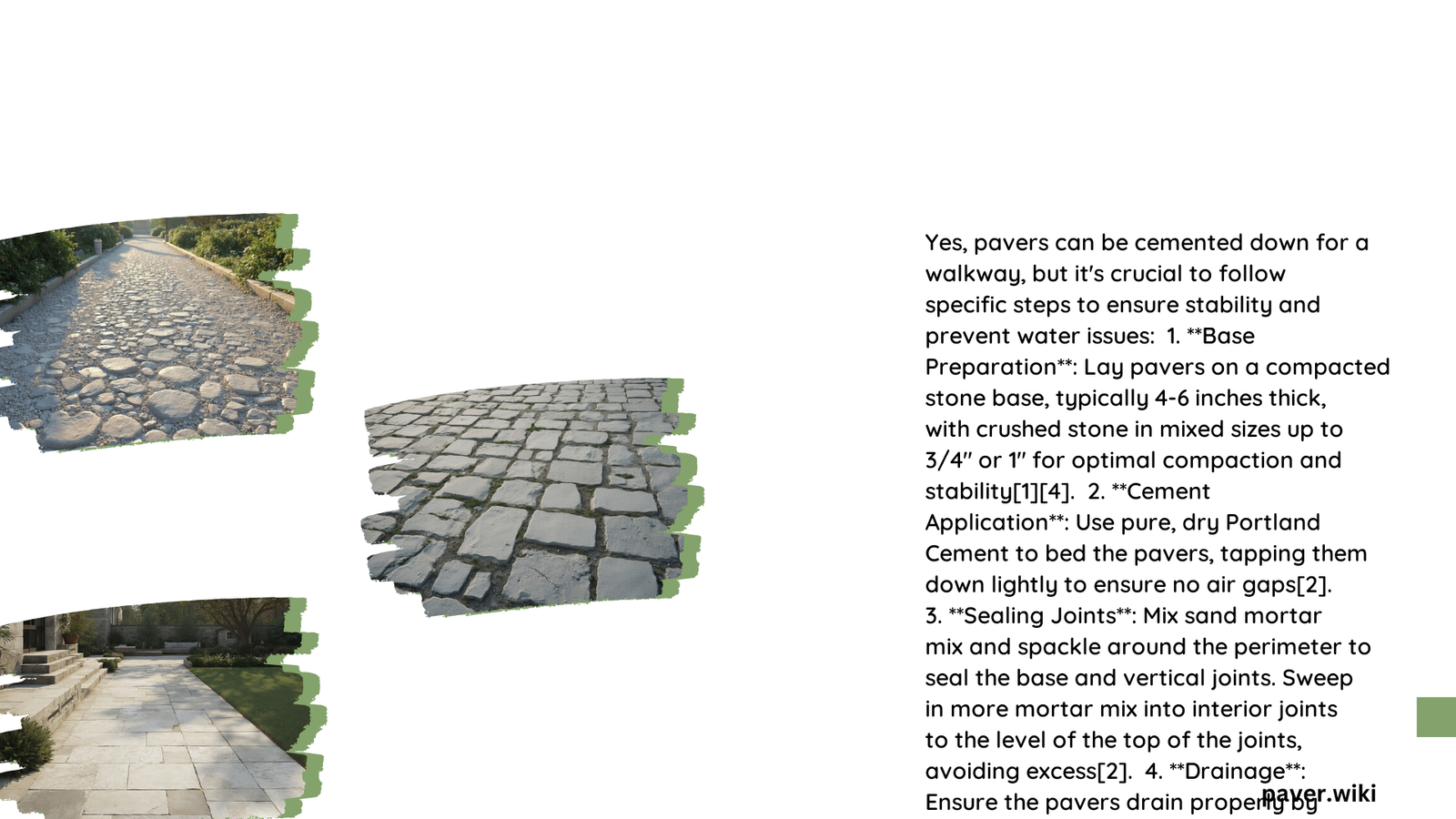Pavers can indeed be cemented down for a walkway, offering a durable and long-lasting solution for outdoor pathways. This method, known as the ‘mortar set’ system, involves using a concrete base and mortar to secure pavers in place. While more labor-intensive than sand-set methods, cemented pavers provide superior stability and longevity, making them an excellent choice for high-traffic areas or regions with challenging weather conditions.
What Are the Key Components of Cementing Pavers for a Walkway?
The mortar set system for cementing pavers involves several crucial components:
- Concrete base
- Mortar bed
- Pavers
- Jointing mortar
Each of these elements plays a vital role in creating a stable and durable walkway.
How Is the Concrete Base Prepared?

The concrete base is the foundation of a cemented paver walkway. Here’s how it’s typically prepared:
- Excavate the area to the required depth (usually 6-8 inches for a walkway).
- Compact the soil thoroughly.
- Add a layer of gravel or crushed stone (about 4 inches) and compact it.
- Pour a concrete slab, typically 4-6 inches thick.
- Allow the concrete to cure for at least 28 days before proceeding.
What Type of Mortar Is Used for Setting Pavers?
For setting pavers, a specific type of mortar is recommended:
- Type S or Type N masonry mortar: These are suitable for outdoor applications due to their strength and weather resistance.
- Mix ratio: Typically 1 part Portland cement to 3 parts sand, with water added to achieve the desired consistency.
- Thickness: The mortar bed is usually spread 1-2 inches thick over the cured concrete base.
How Are Pavers Installed in the Mortar Bed?
The process of installing pavers in the mortar bed involves several steps:
- Spread the mortar evenly over the concrete base.
- Place pavers into the mortar, ensuring they are level and properly spaced.
- Use a rubber mallet to tap pavers into place.
- Check for levelness frequently using a straight edge or level.
- Allow the mortar to set according to manufacturer’s instructions (usually several hours to a day).
What Are the Jointing Methods for Cemented Pavers?
After the pavers are set, the joints between them need to be filled. For cemented pavers, mortar joints are typically used:
- Mix mortar to a slightly wetter consistency than the setting bed.
- Fill joints completely using a mortar bag or by spreading with a trowel.
- Tool the joints for a neat appearance and to ensure they’re fully packed.
- Clean excess mortar from the paver surfaces before it hardens.
What Are the Advantages of Cementing Pavers for a Walkway?
Cementing pavers for a walkway offers several benefits:
| Advantage | Description |
|---|---|
| Stability | Cemented pavers are less likely to shift or settle over time. |
| Durability | The rigid base and secure setting make cemented pavers more resistant to damage. |
| Longevity | A properly installed cemented paver walkway can last 20-30 years or more. |
| Low Maintenance | Cemented pavers require less frequent maintenance than sand-set pavers. |
| Weed Resistance | Mortar joints prevent weed growth between pavers. |
Are There Any Disadvantages to Cementing Pavers?
While cementing pavers has many advantages, there are some potential drawbacks to consider:
- Higher initial cost: The materials and labor required for a cemented paver installation are more expensive than sand-set methods.
- Difficulty of repair: If a paver needs to be replaced, it’s more challenging with cemented installations.
- Less flexibility: Cemented pavers don’t allow for natural ground movement, which could lead to cracking in some cases.
- Longer installation time: The process of cementing pavers takes longer due to concrete curing times.
How Does the Durability of Cemented Pavers Compare to Other Methods?
Cemented pavers generally offer superior durability compared to other installation methods:
- Load-bearing capacity: Cemented pavers can handle heavier loads than sand-set pavers, making them suitable for driveways as well as walkways.
- Resistance to erosion: The mortar joints between cemented pavers are less susceptible to washing out during heavy rains.
- Freeze-thaw resistance: When properly installed, cemented pavers are less likely to heave during freeze-thaw cycles.
What Maintenance Is Required for Cemented Paver Walkways?
While cemented paver walkways require less maintenance than sand-set alternatives, some upkeep is still necessary:
- Regular cleaning: Sweep or hose down the walkway to remove dirt and debris.
- Sealing: Apply a paver sealer every 3-5 years to protect against stains and weathering.
- Joint inspection: Check mortar joints annually for any cracks or deterioration.
- Repairs: Address any loose or damaged pavers promptly to prevent further issues.
In conclusion, cementing pavers down for a walkway is a viable and often preferred method for creating durable, long-lasting outdoor pathways. While it requires more initial investment in terms of time and materials, the resulting walkway offers superior stability and longevity compared to other installation methods. By carefully considering the advantages and disadvantages, homeowners can make an informed decision about whether cemented pavers are the right choice for their walkway project.
References:
1. Ideal Concrete Block: Concrete Paver Installation
2. Mason Contractors: Brick Paver Installation Methods
3. Oregon State University Extension: 10-Step Guide to Installing Pavers
